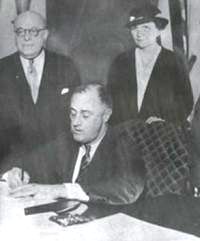Remembering the Memorial Day Massacre of 1937. The Wagner Act 1935, Right To Unionize
'Remembering the Memorial Day Massacre of 1937,' Daily Kos, May 28, 2021. -Ed.

- The Chicago Memorial Day 1937 Incident (National Archives).
________
This article first appeared on the Kentucky State AFL-CIO website.
- The "Memorial Day Massacre" is not well known today, even among many union members. But the atrocity is a stark reminder of corporate America’s often violent resistance to organized labor. -
By BERRY CRAIG, AFT Local 1360
“Few people think of unions or the plight of the working class when they think of Memorial Day,” Ahmed White wrote in Jacobin magazine 4 Memorial Days ago. “But they should,” he added. That goes double for those of us who pack union cards. Here in Kentucky, and nationwide, thousands of union members and their families and families will enjoy the holiday. Few, if any, will pause to remember the "Memorial Day Massacre" of May 30, 1937, in which Chicago police, at the behest of a fiercely anti-union steel company, fired on and beat up a crowd of peaceful strikers and their families and supporters. The cops killed 10 and wounded more than 100.
“Autopsies showed the bullets had hit the workers in the back as they were running away,” Howard Zinn wrote in A People’s History of the United States.
- The 1937 Chicago Memorial Day Massacre: police, workers, laborers, rioters; tear gas, batons, arrests, police brutality.
In my neck of the deep western Kentucky woods, people who have Memorial Day off might go boating or fishing on Kentucky Lake or Lake Barkley, play a round of golf at Paducah’s Paxton Park or maybe have a picnic in Columbus-Belmont State Park. Rainy weather is about all the only fun spoiler they'll have to worry about. They almost certainly won't have to run for their lives from from rogue cops shooting, clubbing and tear-gassing them. The "Memorial Day Massacre" is not well known today, even among many union members. But the atrocity is a stark reminder of corporate America’s often violent resistance to organized labor.
Two years before the massacre, Congress passed the Wagner Act. The landmark legislation triggered an unprecedented wave of union organizing, especially in mining and industry. The act gave workers the right to unionize and required employers to recognize the union when a majority of workers voted the union in. As a result, millions of working men and women flocked to unions. Despite the Wagner Act, many companies refused to accept unions. Ferociously anti-union, Henry Ford hired and armed a private army to keep the United Auto Workers (UAW) out of his plants.
Other industrialists did likewise including union-despising Tom Girdler, president of Republic Steel. United States Steel, dubbed “Big Steel,” signed a contract with the Steel Workers Organizing Committee (SWOC), part of the Committee for Industrial Organization, later the Congress of Industrial Organizations (CIO).
Republic and 7 other smaller steelmakers, nicknamed “Little Steel,” would not accept the SWOC. As a result, the union called a strike at Republic and 2 other "Little Steel" companies.
On Memorial Day, 1937, union sympathizers and members of other Chicago unions joined the Republic strikers and their families for a rally outside a tavern across the prairie from the Republic plant. The tavern doubled as SWOC local headquarters. -"Because it was such a fine summer day, many of the strikers brought their children...and wherever you looked, you saw two-year-olds and three-year-olds riding pick-a-back on the shoulders of steelworkers," wrote historian Howard Fast. And because it was in the way of being their special occasion as well as a patriotic holiday, the women wore their best & brightest." - ...
Read More & Comments,
https://www.dailykos.com/stories/2021/5/28/2032556/-Remembering-the-Memorial-Day-Massacre-of-1937
_________
- The National Labor Relations Act of 1935 (aka the *WAGNER ACT) is a foundational statute of U. S. labor law that guarantees the right of private sector employees to organize into trade unions, engage in collective bargaining, and take collective action such as strikes. Central to the act was a ban on company unions. The act was written by Sen. Robert F. Wagner, passed by the 74th U.S. Congress, and signed into law by President Franklin D. Roosevelt.

- President Franklin Roosevelt signs the Act, July 5, 1935 with Rep. Theodore A. Peyser (D-NY, left) and U.S.Secretary of Labor Frances Perkins (right).
The National Labor Relations Act seeks to correct the "inequality of bargaining power" between employers and employees by promoting collective bargaining between trade unions and employers. The law established the National Labor Relations Board to prosecute violations of labor law and to oversee the process by which employees decide whether to be represented by a labor organization.
It also established various rules concerning collective bargaining and defined a series of banned unfair labor practices, including interference with the formation or organization of labor unions by employers. The act does not apply to certain workers, including supervisors, agricultural employees, domestic workers, government employees, and independent contractors.
The NLRA was strongly opposed by conservatives and members of the Republican Party, but it was upheld in the Supreme Court case of NLRB v. Jones & Laughlin Steel Corp. >The 1947 TAFT–HARTLEY ACT amended the NLRA, establishing a series of labor practices for unions and granting states the power to pass right-to-work laws...more,
https://en.wikipedia.org/wiki/National_Labor_Relations_Act_of_1935
_________
- Labor History: Chicago Memorial Day Massacre, 1937. Archive video produced by the Illinois Labor History Society. This is a video every union worker needs to witness in order to appreciate a little of what our elders went through.
_________
- The article, 'Remembering the Memorial Day Massacre' 1st appeared on the Kentucky State AFL CIO website.https://ky.aflcio.org/news/remembering-memorial-day-massacre-1